Gas Outdoor Fireplaces
Information on natural gas and propane-fueled outdoor fireplaces
-
A ceramic log set can be added to a gas fireplace to create authenticity.
-
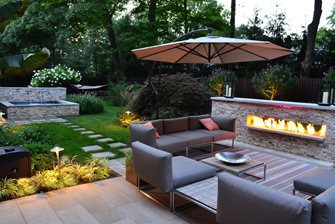 Gas fireplaces are especially popular for modern, chimney-less designs.
Gas fireplaces are especially popular for modern, chimney-less designs.
-
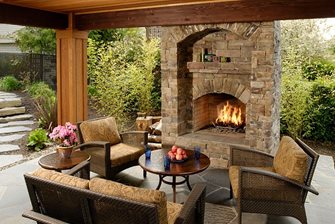 When compared to wood, a gas fireplace is much easier to use and maintain.
When compared to wood, a gas fireplace is much easier to use and maintain.
-
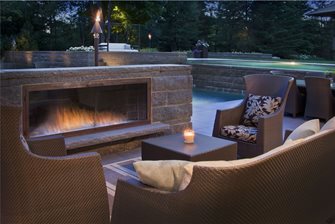 A variety of flame effects can be created with various burner styles and decorative fillers.
A variety of flame effects can be created with various burner styles and decorative fillers.
- 1
- 2
- 3
- 4
In many ways the parameters for design of your outdoor fireplace will be similar to those used indoors. In most homes, fireplaces are fitted with gas to allow the enjoyment of a warm fire without the need to buy and store wood. The same is true outdoors to eliminate firewood and the environmental issues it creates. In many communities, wood burning fireplaces, whether indoors or out are strictly forbidden due to issues of air quality. These same cities will often restrict them outdoors as well. Gas becomes the ultimate solution.
Adam Heath of Mid Atlantic Enterprise of Williamsburg, Virginia has built many high end fireplaces and fire pits. "Ninety percent of our clients start with a wood fireplace, then switch to gas. Wood is not a renewable resource and it creates a lot of maintenance to keep the fireplace clean."
With such an overwhelming change, it's clear that nearly every customer will in the end, switch to gas. Therefore it's wise to install it even if you don't think you'll use it because your lifestyle may change over time.
Heath is also keen on operation. "We have ceased using push button igniters because they fail, but fully automated systems are still best for customers who do a lot of entertaining. However, I prefer a manual route using a key to turn on the gas, with a timer that's able to shut it off at a designated time such as the end of a party. We strive to locate all turn offs close by, but there are remote systems available that help you shut it down from any part of the property."
Despite the presence of gas, many fireplaces today are built to provide customers with the option of burning wood too. For this reason, many newer fireplaces are designed with spaces for storing firewood out of the weather so it's always at hand for an impromptu blaze.
Propane or Natural GasOutdoor fireplaces can be fitted with either propane or natural gas depending on what's available on site. Propane tanks can be located virtually anywhere while all natural gas must tie into the house supply lines. This designates the chief difference which dictates how much it will cost to supply gas to your proposed fireplace location. Often when integrated into an outdoor kitchen or grilling area, gas is already there to easily hook up. Without existing supply, costs can rise as piping of natural gas requires long expensive runs of buried lines.
Propane
Liquid propane is a more efficient gas because it provides 2500 BTUs while the same volume of natural gas produces just 1000 BTUs.
But if there's no propane tank existing, a new one should be installed strictly for the fireplace and perhaps an outdoor grill as well. Depending on small portable tanks for these high flow amenities would require frequent tank change outs. The optimal new tank can be large and permanently installed at a location that will balance accessibility for refilling which proximity to the fireplace location to limit trenching and piping distance.
Natural Gas
While natural gas doesn't burn as hot as propane, it is just 1/6th the cost.
Most homes in urban and high density suburban communities are fitted with natural gas. It is preferable to propane because there is no need to have a tank refilled. The gas flows unlimited making high demand fire features easy to use without concerns of fuel shortages and refill appointments. Natural gas does not fluctuate in price like propane either.
When locating an outdoor fireplace, always keep the hook up location in mind. The further you must go the more costly the project. It may require you to trench all the way to the gas meter or a closer junction. Gas line, due to its potential volatility if damaged is buried deep underground to prevent conflicts. The Uniform Building Code and local ground freeze depth dictate how deep a trench must be and the kind of pipe necessary to lay a new line to serve the fireplace.
|
Contributing Author: Maureen Gilmer, contributing writer for Landscaping Network, author and syndicated columnist |



 Outdoor Fireplaces
Outdoor Fireplaces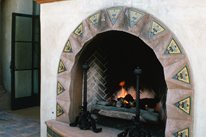 Wood Burning Fireplaces
Wood Burning Fireplaces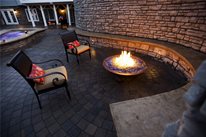 Gas Fire Pits
Gas Fire Pits

